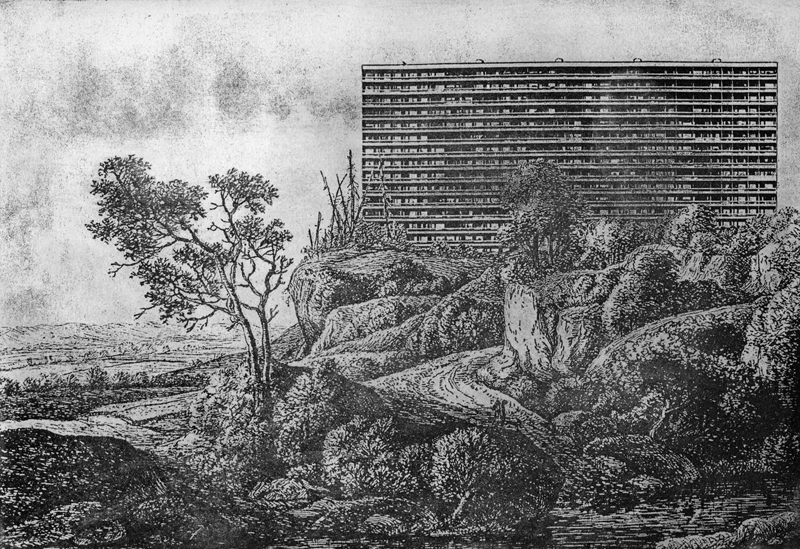
Metamodernism is above all about oscillation. Or at least for me it is. It is about the oscillation between the modern and the postmodern, history and ahistoricity, optimism and pessimism, sincerity and irony, the concept and the material, the figurative and the formless, narrative and the plotless, discursive originality and individual intertextuality, meaning and meaninglessness. (To be sure, contrary to what the above might suggest, it is not so much about the oscillation between binary opposites, as between the various ends on a multidimensional continuum of energies and intensities.)
One oscillation that has become particularly poignant of late is the oscillation between what might perhaps best be called ‘hardness’ and ‘softness’. Hardness here means a social ruthlessness and austerity as well as a physical firmness. Softness similarly can intend both sensitivity or empathy and the smoothness, silkiness or furriness of a substance. In what follows, I briefly explore (and it is a tentative exploration really, an attempt to come to grips with) two exemplary practices.
The brilliant writing of Roberto Bolano is illustrative of the oscillation between hardness and softness. Bolano’s style is frequently epic and evocative, replete with grand gestures and long sentences, but it is also often (and unfortunately I can speak about the English translation only here) staccato, a stop-motion stream of hurried and barely finished sentences and interrupted thoughts. Indeed, novels like 2066 and The savage detectives create a narrative fabric, it seems, only to write into the non-narrative gaps (plot lines without diegetic past or future). Similarly, if the worlds Bolano narrates are frequently terrible and terrifying, a labyrinthic, grim and murky setting for dispassionate murders, calculated violence and harsh words, the vagrants, poets and students that occupy it repeatedly manage to establish impossible, severely flawed yet sincere and heartfelt, but mostly just extremely human, connections.
Another striking example is the work of the French artist Cyprien Gaillard. His various videos, installations, collages and paintings all concern themselves with the tension between modernist architecture and nature, between Reason and ruins. His most obviously Romantic piece Belief in the Age of Disbelief (2005) situates a modernist housing block amidst an idyllic 17th century Dutch landscape (not entirely dissimilar indeed to the works of Peter Doig and David Thorpe I discussed earlier). The hard, straight vertical and horizontal lines of the housing block contrast with the softer, curved, undulated lines of the trees and the hilltops; its homogenous anonymity with the nature’s inviting diversity. Yet surprisingly, the housing block does not suppress nature, but appears to be subsumed by it; instead of symbolizing a future of Reason, it comes to represent a ruin from an incomprehensible, mythical past.
In his more recent, (in)famous Desniansky Raion (2008), the tension between modernism and nature, Reason and ruins, but also between hardness and softness paradoxically becomes both unbearably manifest and evasively mythical. In a series of videos, Gaillard monumentalizes modernist architecture across a number of European cities. In the first video, modernist buildings outside of St. Petersburg become the boxing ring for massive, orchestrated yet completely irrational and harrowing fistfights between local fight clubs (evoking 18th century battles between neighbouring towns). In the second section, a Paris housing block in the process of demolition becomes the stage for an estranging, otherworldly light show (tellingly, an artistic practice usually reserved for castles, ruins and monuments). And in the third part, an Ukrainian estate comprised of high, anonymous flats, is turned into a modern Stonehenge: a choreography of closed, silent witnesses of a past whose laws, rules, norms and values have become incomprehensible to us.
For that is what Gaillard’s work is about: by pairing the modernist architecture with transcendence, sensuality and aggression, that is, by coupling the hard, cold and calculated to the indeterminable and fluent, Reason to the irrational, the past future to the future past, he tries to write a hauntology, that is, tries to inscribe the inhuman into the annals of human myth (however horrible that myth may be).
In Bolano as well as Gaillard’s work (or Djurberg, or even Eliasson, or P.T. Anderson, or The Wire) the unbearably hardness is, impossibly, at the same time the sought-after softness. A (post)modern world of failed utopias, missed chances and cynical deconstruction is represented as a horrendous, terrible place; but a place, still, a lived space of relationships and history, where one can begin to try and live again.
Image: Cyprien Gaillard, Belief in the Age of Disbelief (2005). Courtesy Laura Bartlett Gallery.
